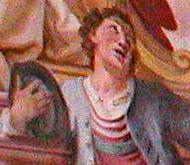Matthäus Günther facts for kids

Matthäus Günther (sometimes spelled Mathäus Günther) was a very important German painter. He lived from 1705 to 1788. He was a leading artist during the Baroque and Rococo art periods.
Günther was born in a place called Peissenberg. He played a big role in creating the Rococo style of painting in Bavaria and Tyrol. He worked on more than 40 churches! We know he created about 70 large wall paintings called frescoes and 25 panel paintings. People especially admired his art for looking very real and having bright, lively colors.
He studied painting in Munich from 1723 to 1728. His teacher was Cosmas Damian Asam, who was also a famous artist. Günther became very good at fresco painting in Augsburg. He often worked with other amazing artists of his time. These included the architect Johann Michael Fischer and the plasterers Johann Michael Feuchtmayer and Franz Xaver Feuchtmayer. Matthäus Günther passed away in Haid, near Wessobrunn.
Famous Artworks
Matthäus Günther created many beautiful artworks, especially frescoes, in churches. Here are some of his most famous projects.
Art in Bavaria
- Amorbach—Benedictine Abbey Church of St. Maria: He painted the high altar and ceiling frescoes between 1742 and 1747.
- Dießen am Ammersee—Church of St. Georgen: He contributed parts of the altar in 1750.
- Friedberg—Pilgrimage Church of the Peace of the Lord: He painted the ceiling in the main part of the church in 1747 and 1764.
- Garmisch-Partenkirchen—New Parish Church of St. Martin: He created ceiling frescoes in 1733.
- Greisstätt-Altenhohenau—Monastery Church of St. Peter and St. Paul: He painted a fresco in the choir section.
- Indersdorf—Augustinian Canonry: He painted frescoes showing the life of St. Augustine in 1755.
- Mittenwald—Parish Church of St. Peter and St. Paul: He painted ceiling artworks and the high altar in 1740 and 1746.
- Oberammergau—Catholic Parish Church: He created frescoes in 1759 and 1761.
- Polling bei Weilheim—Augustinian Canonry Church: He painted a fresco of Parnassus in the lay brothers' dining hall from 1775 to 1778.
- Rott am Inn—Benedictine Abbey Church of St. Marinus and St. Anianus: He painted dome frescoes and other frescoes in 1763.
- Rottenbuch—Augustinian Church of Birth of the Virgin: He painted frescoes about the life of St. Augustine in 1750.
- Schongau—Parish Church of Mariae Himmelfahrt: He created frescoes in 1753.
- Wessobrunn—Kreuzberg Chapel: He painted ceiling frescoes from 1771 to 1772.
- Wessobrunn—Pilgrimage Church of St. Leonhard im Forst: He painted ceiling frescoes in 1761.
- Würzburg—Pilgrimage Church of St. Maria (Marienkapelle): He created frescoes in 1752.
Art in Tyrol
- Fieberbrunn—Chapel of Johann Nepomuk: He painted frescoes in 1762.
- Fiecht—Collegiate Church of St. Josef: He created frescoes from 1740 to 1744.
- Götzens—Parish Church of the Apostles Peter and Paul: He painted dome frescoes showing the lives of Peter and Paul in 1775.
- Grins—Parish Church of St. Nikolaus: He worked on stucco and ceiling paintings in 1779.
- Innsbruck—Chapel of Schloss Mentelberg: He worked on stucco and ceiling paintings here.
- Innsbruck—Wilten Basilica: He created ceiling frescoes in 1770.
- Rattenberg—Parish Church of St. Virgil: He painted ceiling frescoes and a fresco in the sacristy in 1736.
Images for kids
-
Fresco (1755) showing scenes of the Battle of Lepanto in the Augustinian Canonry in Markt Indersdorf
See also
 In Spanish: Matthäus Günther para niños
In Spanish: Matthäus Günther para niños



